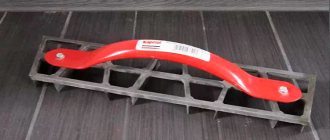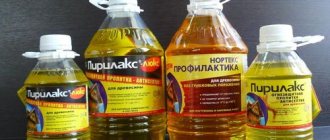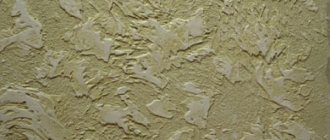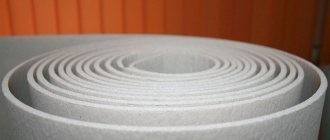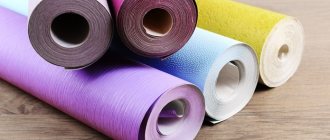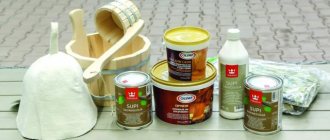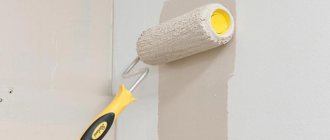Most owners of private plots prefer to build a bathhouse on their property, since in this universal place you can not only wash, but also rest, relax, and improve your health.
According to tradition, natural wood materials are used to build a bathhouse, so that the healing effect of the steam room is greatly enhanced. But it’s no secret that when exposed to high temperatures, wood tends to deteriorate. So what to do in this situation?
The importance of processing the structural elements of the bathhouse
By its natural origin, wood is an excellent natural material, which is distinguished not only by its environmental friendliness and aesthetic properties, but also by its good hygroscopicity. The tree absorbs moisture quite thoroughly and quickly, creating a very favorable habitat for fungi, microorganisms and insects.
Important! Insects that can settle in your bathhouse can quickly destroy the structure of the wood.
It is worth noting that excessively high air humidity in a bath room contributes to rotting and damage to wooden elements by mold, parasites, and so on.
Every person starting the construction of a bathhouse is well aware of the need to install high-quality heat, hydro and vapor barriers, since without these layers the building structure will be completely vulnerable, and the desired effect should not be expected from the steam room.
Impregnation for a bath plays the same important role as an insulating cake, despite the fact that many are still arguing about whether it is necessary to treat the lining in a steam room. Protection in the bathhouse should be provided to tables, shelves, benches and other interior elements. The steam room especially needs protection, since it is in this room that the temperature varies to critical levels.
If the wood in the steam room is not treated, then under the influence of steam and moisture it will quickly deteriorate, as a result of which it will have to be replaced or repaired.
Attention! The choice of impregnation composition for the inside of the bath should be approached as responsibly as possible in order to avoid further problems.
It is worth noting that doubts about whether it is necessary to process the lining in a steam room are quite justified. This can be explained by the fact that an incorrectly selected composition that will be used to treat the steam room, when heated, can emit vapors harmful to the human body, or leave a burn upon contact with the skin.
Advice for those who are not sure whether it is necessary to process the lining in a bathhouse: you can simply carefully sand the walls and furniture, but in this case it is necessary to ensure the highest quality ventilation so that high humidity does not cause the appearance of mold and fungi.
Ruberoid - from 30 rubles per square meter
If you do not foresee large expenses for arranging the roof of a bathhouse , you should opt for roofing felt - the most economical option. In addition to the attractive price, this material has other advantages, namely:
- simple installation;
- a light weight;
- excellent waterproofing.
It is worth considering the disadvantages: the tendency of roofing material to rupture, low strength indicators, a tendency to fire, fragility. To make the material last longer, it requires laying in several layers.
Which one to choose
In the process of finishing a bathhouse building, many people wonder how to treat the lining in the bathhouse or how to cover the shelves in the bathhouse.
The modern market offers a lot of options for a variety of products, but it is quite difficult to choose from them really high-quality ones.
Before you start choosing an impregnation for the inside of a bathhouse or sauna, you need to decide on the purpose of its use, namely:
- Application object;
- The level of humidity in the room, because the impregnation for the steam room in the bath should be more moisture and heat resistant;
- Will the natural wood texture be preserved or will varnishing and painting be planned?
- How to apply impregnation for the bathhouse inside with your own hands.
Impregnation for wood in a bathhouse must have a large number of properties in order to provide all wooden elements with reliable protection.
Information. In addition to reliable protection, the impregnation for the lining in the bathhouse should ensure unhindered air exchange.
You should also pay special attention to the environmental friendliness of the purchased product, since when heated in a steam room, it can release harmful substances.
Impregnation for the bathhouse floor should not lead to the formation of a sliding surface, and products for frequently used surfaces should be resistant to regular wet cleaning. In turn, the impregnation for the shelves in the bathhouse is absorbed as deeply as possible into the material, providing reliable protection for the structure and the safety of steamers.
Answering the question of how to cover the paneling in a steam room, we note that when drying, the product should not form a film, as this can cause burns on the skin of the person who comes into contact with it.
Where do the dark spots on the lining come from?
There is a whole list of reasons for the darkening of wood paneling in a steam room:
- normal pollution;
- ingress of tannins, which are contained in large quantities in brooms - stains from them are of almost the same nature as deposits from strong brewed tea;
- soot or soot from burning wood;
- white, brown, bacterial mold (leads to wood rotting from the inside);
- black fungus (usually appears on the surface in the form of a dark “spray”);
- blue fungi (manifest as a gray-blue coating on the surface).
boriemsia-s-ghribkom-i-pliesieniu-na-dachie_2.jpg
In the first two cases, removing stains will not be difficult at all - they are superficial and can be easily erased with laundry soap, soda, salt or mustard powder mixed with lemon juice dissolved in water. You should not use chemical detergents to avoid inhaling their vapors during subsequent bath procedures.
voshchenie.jpg
Complex stains, as well as blackening from soot, can be cleaned with an abrasive - sandpaper or a grinding machine. It is better to choose a circle of small diameter (12-13 cm), and a nozzle with a grain size of up to 35 units. After finishing work, you must thoroughly vacuum the room and wash off any remaining dust with a damp sponge or cloth.
shlifovka-sten1.jpg
Types of protective equipment: how to impregnate the lining inside the bathhouse, as well as other structural elements
To treat lining in a bathhouse and wooden elements in a residential building, you will need completely different solutions.
And the point here is not even in the design of the building, but in such a critical difference in the atmosphere of the premises.
Thus, in a bathhouse it is more aggressive, and the usual means used in a residential building will simply be useless here.
There are the following types of impregnations for log baths:
- Finnish impregnations for baths and saunas, providing protection against moisture;
- Means for processing lining inside the bathhouse;
- Prevents the appearance of mold, mildew and parasites;
- For a bath outside.
Attention! Despite the fact that many manufacturers claim their products as universal, most of them are not.
These drugs can be produced in various forms:
- Aerosol;
- Solution;
- Gel.
Important! You should not use aerosols to impregnate your bath with your own hands if you have any respiratory diseases. It is best to choose a gel product.
Impregnations for wood for baths and saunas are made either on an organic or chemical basis. Of course, if the question arises of how to cover the lining in the steam room, it is best to stick with organic solutions.
Each product has water-repellent properties, since modern drugs rarely perform only one function. Thus, one product can simultaneously protect the tree from the effects of temperature and moisture, as well as from parasites and microorganisms.
According to their composition, wood impregnations for indoor baths are divided into:
- Water soluble;
- Oily.
In addition, new combined varnishes and paints with moisture-proof properties, as well as protection against the appearance of microorganisms and parasites, are widely used.
Information. Most manufacturers produce preparations with new additional properties of dirt repellency and fire resistance.
Processing Tips
To extend the service life of wood, it is recommended to treat surfaces with protective impregnation at least once every two years. It is better to plan these works for the autumn. You need to choose the impregnation that is marked that it is intended for use in bath conditions (appropriate temperature, humidity).
An antiseptic for a bath should be applied exclusively to a cleaned surface. From the wood, you first need to clean off the old varnish, paint (if there was any), damaged layers, sweep away the dust, and then apply the product only with a soft and wide brush. To prepare the surface, it is most convenient to use a grinding machine.
To add a tint to the protective impregnation, you can add a little dye. The lower crown of the bathhouse frame is best treated with a bitumen-based composition; it perfectly protects against rotting.
The foundation must be protected with waterproofing, otherwise it will begin to rot over time. It is advisable to cover surfaces that will most often come into contact with water with several layers of impregnation. You can use the bath only after the composition used has completely dried.
When a house has been built on the site and renovations have been made, it’s time to think about building a bathhouse. This is a great place where you can relax after a difficult week of work and just have a good steam. Therefore, I want this place to be as comfortable as possible. And in order to decorate the bathhouse and steam room, they try to use natural materials that will create a favorable microclimate indoors.
Therefore, a bathhouse built from wood would also like to be treated with materials created on its basis. A fairly common material for finishing a bathhouse is lining. Today it is represented by a wide range, among which every consumer will be able to choose the option that suits them.
But when finishing with such material, the question always arises: is the lining required to be treated, and if so, what to use to cover the lining in the bathhouse. Here opinions differ, since this point can be viewed from two sides. If the walls are not covered with protective agents, then over time they will become unusable, begin to become moldy and rot, and the color of the walls will lose their original attractive appearance.
How to treat the interior of the lining: distinctive features of water-soluble and oil-soluble solutions
Water-soluble and oil-based bath impregnations differ both in composition and properties. Let's take a closer look.
How can you cover the lining in a bathhouse: water-soluble products
Acrylate is used as a basis for the manufacture of water-soluble products.
The finished product protects the structure from all fronts: from moisture, from microorganisms and parasites, from dirt and damage.
The solution can be either colorless or colored. In order for it to turn into the desired color, you need to add a drop of dye to the product.
This solution also has advantages. These include the complete absence of odor, as well as the preservation of the appearance and texture of the wood.
Attention! The disadvantage of this product is its gradual leaching from the surface of the wood. Because of this, processing has to be repeated somewhat more often.
How to treat lining in a steam room: oil products
The advantage of oil products is that they are deeply absorbed into the wood and retain their properties for quite a long time, despite frequent moisturizing.
However, this solution has a strong unpleasant odor, which is explained by the solvent in the composition.
Information. Due to the increased toxicity of the drug, it is not recommended to use it in closed and poorly ventilated areas.
Impregnations containing oils and wax seal wooden elements and provide them with long-term protection.
Slate - from 150 rubles per square meter
Most homeowners use asbestos-cement slate for roofing bathhouses and outbuildings. Attracted by the inexpensive cost of the coating, its durability, non-corrosion, quick and easy repairs if necessary.
It has slate and disadvantages, namely:
- fragility;
- heavy weight;
- loss of external attractiveness over time.
During operation, the material may become covered with moss and deteriorate. To prevent this from happening, regular maintenance is required.
Products for lining in the washroom and dressing room
Finnish impregnations for baths and saunas are a clear favorite in this segment. The most famous representative is the impregnation for baths and saunas Tikkurila.
The domestic analogue of Tikkuril impregnation for baths is the product.
Both products have an organic composition, that is, they are absolutely environmentally friendly.
Also an undoubted advantage is the ease of cleaning surfaces coated with these products, since when they dry they form a thin film.
Among other things, these compositions have protective properties against fungi and microorganisms.
How to cover the lining in the bathhouse? An excellent product is Eurotex-Sauna, which is made on a wax basis and has antiseptic properties.
This impregnation for shelves in a bathhouse or sauna is a colorless product that forms a thin protective film on the surface of shelves and other interior items.
Information. After treating the bathhouse with these products for three to five visits, a specific, but not very pronounced odor is present in the room.
Homemade recipes
There is a recipe for homemade wax impregnation, which includes beeswax and linseed oil, the ingredients are taken in equal proportions. The grated wax is melted in a water bath, and then it is mixed with the second component and allowed to cool.
It is recommended to use harmless protective materials to impregnate the walls of the steam room. The use of oils allows you to create a greasy film on the surface of a wooden structure and protect the wood itself from penetration deep into dirt. There is one minus here. For some time after contact with the treated surfaces, a greasy film will be felt, but soon the oil will be absorbed and partially erased, leaving only a protective film.
A good result is obtained after using melted natural wax. This impregnation is easy to do with your own hands. But the surface must first be thoroughly cleaned, degreased and only then wax applied.
Treatment of lining in the steam room and oil for shelves
In most cases, the answer to the question of whether it is necessary to treat the lining in a steam room is negative.
However, if this is still necessary, you should carefully consider the choice of funds.
It is best to use natural oils or waxes for this.
An excellent remedy is flaxseed oil.
When treating a bathhouse shelf with linseed oil, you can add aromatic oils that can radically change your idea of a classic bathhouse.
It is not recommended to impregnate the floor with linseed oil in a bathhouse, since it is quite easy to slip on an oily floor surface and cause serious injuries.
Instead of linseed oil, you can use hemp or sunflower oil to treat the shelves in the bathhouse.
Attention! Sunflower oil for protecting the wooden elements of a steam room can significantly save your money, but you should only use refined and odorless oil.
Another practical plus is that the oily surface of the wooden elements will not allow dirt to penetrate deep into the material. But you should be prepared for the fact that at first there may be greasy marks on your body. You need to be patient a little, after a while the oil will be completely absorbed deep into the wood and will not leave marks on the skin.
Wax is also something that can be used to saturate the lining in a steam room quite simply and inexpensively. First, you need to sand the surface and melt the wax, then you can begin to carefully apply the product.
Using natural products is much better than painting the lining in a steam room. This can be explained by the fact that ordinary varnishes and paints interfere with moisture and air exchange. Wood must absorb excess moisture and then release it again. Painted elements will not be able to do this. Don’t forget about the chemical composition of paints and varnishes, which can emit harmful fumes when heated.
Main selection criteria
Before you evaluate the quality of the main roofing materials, you need to decide which types are suitable specifically for your bathhouse. The assessment must be based on the following factors:
- Amount of precipitation in the construction area;
- The type of roof structure, as well as its angle of inclination;
- The material with which the remaining roofs on the site are covered.
For the most part, the design of the roof of the bathhouse is not complicated and is either single-pitch or gable. It is better to entrust more complex structures to professionals, since without certain skills it is almost impossible to complete the roof of a complex roof.
Important! To cover the roof with a rigid roof, sheathing must be installed. In turn, rolled soft roofing should be laid in a continuous layer on boards or plywood sheets.
When choosing the type of structure for a bathhouse roof, you must be guided by the following criteria:
- If the bathhouse is separate, it is better to install a roof with two slopes. If the bathhouse is an extension - with one. The angle of inclination should not exceed 65 degrees and be at least 45;
- For a bathhouse with an area of more than 12 m2, a gable roof is suitable, for smaller ones - a single-slope one;
- If precipitation in the construction area is heavy, then the roof must be at least 45 degrees, otherwise precipitation will accumulate on the roof, which can lead to damage to the roof;
- If strong winds prevail in the construction area, then the angle of inclination should be less than 40 degrees. This way, the wind will not affect the roof as much.
How to treat the floor and shelves: varnish coatings in the steam room
How to paint the shelves in the bathhouse and can I use varnish for this? Of course it is possible. However, not any varnish coating is suitable for shelves, and even more so for a steam room in a bathhouse.
Important! The safest are acrylics from the company Tikkurila, already known to us.
They are made on a natural basis, and the finished product is heat-resistant, as well as a fairly large selection of colors and shades.
Before painting the lining in a bathhouse with varnish, you should familiarize yourself with its main advantages and disadvantages.
The advantages include:
- Antiseptic in the composition, so before coating it is not necessary to use additional substances to prepare the surface;
- The film formed on the varnished surface does not allow moisture to pass into the wood;
- The varnish coating does not lose its properties even at temperatures above 100 degrees;
- An abundance of colors from which you can choose the one that suits you, or use clear varnish.
You should apply the varnish responsibly.
The first step is to sand the surface of the shelf. This should be done starting with the largest nozzle and ending with the smallest.
Attention! The smallest nozzle performs a polishing role.
After polishing the shelves, wipe them with a damp cloth to remove any remaining sawdust, dust and dirt. Once the wood has dried, you can begin applying varnish. To do this you need to use a brush or roller.
It is very important to ensure that each part is coated with varnish. For hard-to-reach areas, we recommend using a thin brush or sponge.
Information. In order not to make a mistake with the choice of colored varnish, it is first recommended to apply it to a small area in two layers to finally make sure that your choice is correct.
Types of roof structures for baths
Let's look at the types of roofs that are most often used in bathhouse construction:
- Shed roof;
- Gable roof.
A lean-to structure is installed if the bathhouse is an extension to a residential or any other premises. The relatively low cost is the main advantage of this type of structure.
Also, a small roof area allows you to significantly save on covering materials.
Gable roofs are used if the bathhouse is a separate building.
The abundance of materials for gable structures allows you to use your imagination and choose the appropriate type of roof based on color and appearance.
For wooden floors, walls and ceilings
Today there are many impregnations and bleaches for wood in the bathhouse.
The most popular of them is the product of the Slovenian company Belinka; it perfectly protects wooden elements from moisture, fungi and parasites.
It is unacceptable to use this type of product for residential buildings.
Many people believe that simple whitening can be used to bleach the wooden surface of shelves or other elements, but this is completely false and also dangerous.
Attention! Contact of bleach with human skin in a hot steam room can result in second-degree burns, and its vapors themselves are very dangerous for the human body.
Bleaches and classic impregnations have a number of advantages:
- Easy to apply;
- Comprehensive protection;
- Low cost;
- A small amount of time required to dry the applied product;
- Preservation of the appearance of the wooden element.
Types of wooden baths
There are a wide variety of types of baths. But in Russia, the most common are several log bathhouses with distinct national characteristics: Russian, Finnish, Turkish and Japanese.
The Finnish one must have a dry and hot chamber, you can call it a steam room. A distinctive feature of the Japanese bath is the presence of a special vat called “furo” and boiling water in it. The Turkish bath is famous for using various oils and rubbing the body with them.
The most popular bathhouse is the Russian steam room. The air in it can heat up to a maximum of + 70 degrees. The most important rooms in it are the steam room and the washing room, and a secondary, but no less important role is played by the relaxation room.
A bathhouse can be built from rounded logs, planed or laminated timber, or even from boards (i.e., a frame structure, which has now become popular due to its low cost and good thermal insulation properties). You can also use laminated veneer lumber; this material is durable, fire-resistant, thanks to its impregnation with antiseptic and fire retardant. For construction, it is better to use spruce or pine with natural humidity.
The ideal foundation for a wooden bath is a columnar one; it is not expensive and the manufacturing process is not complicated. The roof covering can be anything, the main thing is to insulate the chimney well to avoid fire. You can use metal tiles or tiles; they have good properties and excellent appearance. If the external beauty of the bathhouse is not important, then you can use ordinary roofing felt coatings.
Applying the composition to the shelves
Once you have decided which impregnation to apply to the inside of the bathhouse, be sure to read some tips, rules and requirements for the process itself:
- It is best to treat wooden elements of complex structures before assembly, as this will greatly facilitate the application process in especially hard-to-reach places;
- If you still doubt whether you need impregnation for the shelves in the bathhouse and sauna, then you can play it safe and not cover the surface of the structure with the solution. In this case, the drug is applied only to the internal parts of the wooden elements, and the surface of the shelves is simply sanded;
- It is best to carry out procedures in the warm and dry season, since during this period it will be much easier to dry the room;
- Do not use stains or similar chemical products;
- You can start bath procedures only on the third or fourth day after applying the preparations to the structural and decorative elements of the bath;
- You should not skimp on impregnation, giving preference to cheaper and little-known ones, since such savings can lead to hazardous consequences for health.
Imported funds
Here the traditional and undisputed leader is the Finnish company Tikkurila ( Tikkurila ). This manufacturer really has a wide range of products and the best quality. Are there any disadvantages? Of course there is - this is the price.
For example, Supi Saunasuoja is a water-based acrylic impregnation for steam rooms. Holds temperature up to 120°C. Purpose – antiseptic protection against darkening and mold. There are colorless options - preserving the natural color of the wood, and tinted (allowing you to add shades). When choosing a color, it is recommended to do a test coating.
Apply with a wide flat brush or spray in two layers. Second layer after 2-3 hours What is covered – walls. Not recommended for bath shelves and ceilings. There are other impregnations from the same manufacturer for this purpose.
Supi Laudesuoja is an oil-based impregnation. The substance is odorless and practically colorless, although after application it “highlights” the natural texture of the wood. Purpose - water-repellent and dirt-repellent paraffin impregnation of deep penetration. Creates a protective film layer on the surface. Easy to clean. Apply in one layer to cleaned surfaces. What is covered - bath shelves.
“The question may arise: why create a protective film layer on the surface of the shelves? I will answer. The fact is that our sweat falls on them (the shelves), containing not all, but some part of the periodic table. Being absorbed into the bench, it adversely affects the structure of the wood. Therefore, it is recommended to protect the surface. That's it in a nutshell."
To clean the wooden surfaces of the bathhouse, including before applying impregnation, use the acidic detergent Supi Saunapesu .
What to use outside for wall treatment
Impregnation for the outside of a log house should provide reliable protection against parasites and microorganisms, prevent fire, and also provide an aesthetically beautiful appearance.
After you have decided which impregnation to treat the inside of the bathhouse with, you should also take care of the external protection of the wood.
Need to purchase:
- High-quality antiseptics of foreign or domestic production. These substances are able to be deeply absorbed into wood, thereby increasing its resistance to various fungi and microorganisms;
- Fire retardants can stop the spread of fire. Initially, they are deeply absorbed into the wood material, and when the temperature rises critically, they protrude out, thereby forming a thin film that prevents the spread of fire. This step should not be neglected, since the threat of fire for a wooden structure is always present;
- Among other things, wood needs comprehensive protection from wind, snow and moisture, which is why its surface is coated with special compounds. Today, acrylic and alkyd paints for exterior use are quite popular. In terms of their texture, they can be either “dull” or half transparent. Typically, transparent coatings are chosen by lovers of the natural color and texture of wood.
Since wood is a fairly commonly used material in construction, decoration and manufacturing of furniture and household items, it has not lost its relevance over many centuries, and work with it has become much more advanced.
Thus, it is worth learning about the primer, which is used as an impregnation for wooden walls.
What is the primer intended for and in what cases should it be used? It should be understood that it is primarily intended to extend the life of the wood and to make the finishing process more simplified and, importantly, economical.
It all depends on how you are going to use the wooden structure and what impacts it will have.
Some of them affect the appearance, and some can destroy its structure; there are also those that negatively affect a person’s well-being and health.
What impacts can damage wood:
- The main thing that dries wood and changes its color is sunlight;
- As a rule, high air humidity and excessive rainfall can cause swelling and deformation, and subsequently cause rotting;
- Of course, there are various insect pests that can destroy the structure of a tree.
So, to avoid these negative effects on wood, it is painted, varnished or subjected to other external finishes. However, it should be primed before starting. Why is this?
Such compositions fill all the pores and cracks in the wood, thereby preventing the occurrence of fungus and mold.
Important! If the impregnation contains fungicides and insecticides, then the appearance of such unpleasant things as fungus and mold becomes completely impossible, as well as the appearance of pests.
Of course, not only a primer can do this, but also various protective impregnations, but with the help of priming, the surface of the wood becomes durable and smooth, and the paint will apply to it more evenly and more economically.
It is best to ensure adhesion of the finishing composition to the surface of the wood using a primer, because it no longer peels or crumbles.
It should also be noted that primer, unlike high-quality paint, is much cheaper, and therefore more profitable.
Many people believe that the external treatment of the log house of a bathhouse is completely unnecessary, because previously houses made of wood were built without it and they stood for 100 years! But it is worth taking into account the fact that previously only winter forests with strong and dense wood were used to build bathhouses and houses.
Information. Don’t forget about the aesthetic side of the issue, because the logs will darken quite quickly, and the surface of the wood will become covered with unpleasant blue spots of mold.
Best time for outdoor work
When deciding what to impregnate the exterior of the bath house with, you should also think about the processing time. For the first time, wood is impregnated during initial processing.
But it is worth noting that it does not last long, since it is intended only to ensure safe transportation.
A wooden structure is usually treated with an antiseptic immediately after assembly.
After treatment, the log house is left to dry for at least six months. It is best to do this in the autumn season, in order to begin finishing the bathhouse and subsequent external treatment in the spring.
Attention! It is imperative to treat the ends of the log house so that drying is uniform along the entire length of the log.
Processing methods
But many still want to finish the bathhouse and not return to this issue for many years. Therefore, the question naturally arises, how to treat the lining in the steam room? In this option, you should use folk remedies, or use or apply such a processing material that can be used in a room with high temperature and humidity.
Typically, natural wax and oils are used for this. You can use flaxseed or hemp oil, adding flavorings to your taste. The least expensive option is odorless sunflower oil. It is necessary to treat the boards so that no dirt gets inside the wood.
They also treat it with wax, having previously melted it. But before such treatment, the surface is sanded well, and only then a protective layer is applied.
But the construction market also offers specially created impregnations for steam rooms, which are created on a natural basis and are safe for human health under the influence of high temperatures.
Important point. In a steam room, under no circumstances should you treat the walls with paint and varnish, since in this case the wood will be unable to breathe. And this is a very necessary property for a steam room. As well as fumes from ordinary paints, under the influence of temperatures, will have a detrimental effect on the human body. Even the best paints and varnishes are unsuitable for these purposes.
In order to extend the service life of the steam room, it is necessary to follow the rules for its use, and then mold and mildew will not be harmful to it.
